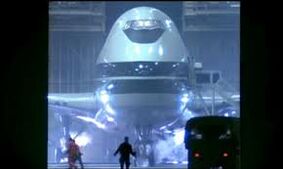The Boeing 747 cargo jet conversion was the getaway airplane that Colonel Stuart and his men used to escape in, but it was foiled by John McClane after he lit the gas trail and blew it up killing all on board.
Description
The Boeing 747 is a wide-body commercial airliner and cargo transport aircraft, often referred to by its original nickname, Jumbo Jet, or Queen of the Skies. Its iconic "hump" upper deck along the forward part of the aircraft make it among the world's most recognizable aircraft and was the first wide-body produced. Manufactured by Boeing's Commercial Airplane unit in the United States, the original version of the 747 was two and a half times larger in capacity than the Boeing 707, one of the common large commercial aircraft of the 1960s. First flown commercially in 1970, the 747 held the passenger capacity record for 37 years.
The four-engine 747 uses a double deck configuration for part of its length. It is available in passenger, freighter and other versions. Boeing designed the 747's hump-like upper deck to serve as a first class lounge or extra seating, and to allow the aircraft to be easily converted to a cargo carrier by removing seats and installing a front cargo door. Boeing did so because the company expected supersonic airliners (development of which was announced in the early 1960s) to render the 747 and other subsonic airliners obsolete, while the demand for subsonic cargo aircraft would be robust well into the future. The 747 was expected to become obsolete after 400 were sold, but it exceeded critics' expectations with production passing the 1,000 mark in 1993. By July 2014, 1,500 aircraft had been built, with 51 of the 747-8 variants remaining on order.

Hangar 11 with the plane.
The 747-400, the most common passenger version in service, has a high-subsonic cruise speed of Mach 0.85–0.855 (up to 570 mph or 920 km/h) with an intercontinental range of 7,260 nautical miles (8,350 mi or 13,450 km). The 747-400 passenger version can accommodate 416 passengers in a typical three-class layout, 524 passengers in a typical two-class layout, or 660 passengers in a high density one-class configuration. The newest version of the aircraft, the 747-8, is in production and received certification in 2011. Deliveries of the 747-8F freighter version to launch customer Cargolux began in October 2011; deliveries of the 747-8I passenger version to Lufthansa began in May 2012. The 747 is to be replaced by the Boeing Y3 (part of the Boeing Yellowstone Project) in the future.

